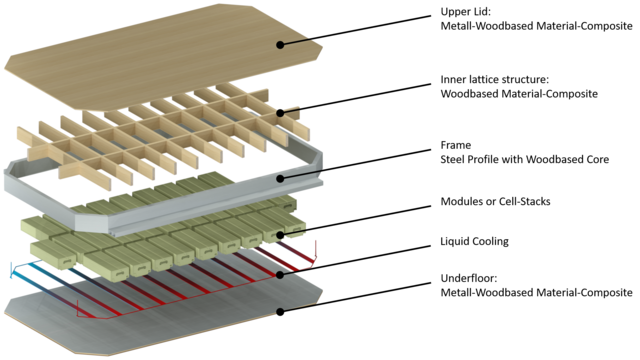The batteries of long-range electric vehicles now extend over the entire underbody between the chassis and the rear axle. between the chassis and rear axle. Accordingly, the battery accounts for a significant proportion of the overall vehicle in terms of cost, mass and volume. In order to reduce the vehicle mass, batteries are increasingly integrated into the vehicle in a structure-supporting manner and have to absorb drive-dynamic loads (torsion, bending) as well as crash loads. The battery housing assumes thereby a variety of additional functions: passive (insulation) and active (cooling, heating) thermoregulation, prevention of catastrophic battery failure by limiting thermal runaway to smaller areas, protection of the occupant from the consequences of catastrophic battery failure battery failure (fire, gases, heat, explosion) and protection of battery from vibration, shock, impact, intrusions and environmental agents with the aim of increasing service life and failure safety.
Currently, steel, aluminum and steel-aluminum hybrid designs are commonly used for battery housings. Battery housings made of aluminum are lighter, more expensive and cause significantly more CO2 emissions during production than comparable housings made of steel. The aluminum battery housings are also at a disadvantage in terms of fire protection due to their relatively low melting point. Thus, safety, weight and cost factors must be considered when choosing materials and suitable new approaches are needed concerning materials.
Wood as a bio-based material has numerous strengths that can be exploited when used as a construction material in a battery housing: low thermal conductivity, excellent vibration damping, very high specific stiffness and strength, high impact energy absorption transversely to the fiber, abundance of raw materials, low material costs, good and low-cost machinability, low ecological footprint, and a well-calculable burn rate in case of fire. By combining wood- and steel-based materials in a battery housing, favorable structural-mechanical and thermal properties of both materials can complement each other and therefore be utilized. Due to this so-called functional integration the weight and installation space of current state-of-the-art battery housings shall be reduced at lower cost and with a smaller ecological footprint than comparable aluminum battery housings, while meeting mechanical, thermal and safety-related requirements.
The use of wood as a material in mechanical engineering could create a link between two important economic sectors in Austria (wood/forestry with 110,000 employees and mechanical engineering with 80,000 employees) and thus increase the added value and independence from raw materials in Austria and and Europe.
In the projects "WoodC.A.R." and "MoveWood", the usability of wood for structural-mechanical elements in mechanical engineering was demonstrated. In Bio!LIB", it shall be proved that also the further favorable physical properties of wood can be used for functional integration. At the same time, measures to increase the performance and reduce the manufacturing costs are being investigated.

